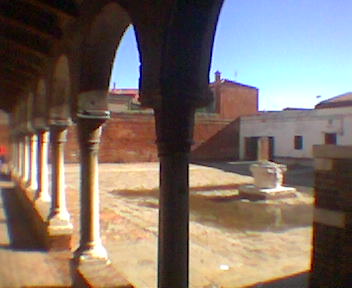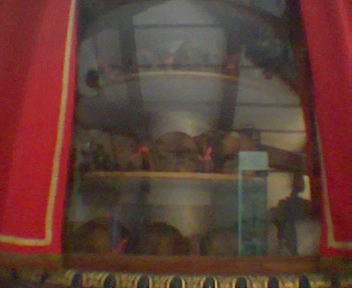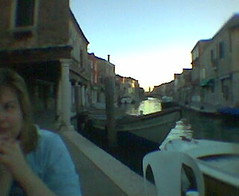You know, after living in Italy for years, part of my brain vainly begins to assume that I'm immune to "culture shock." And then, inevitably, I'm shocked back into the realization that I'm never, ever going to be totally immune.
This past weekend, we went to a open-air theater in Murano, the glass-blowing island just a stone's throw from Venice. As you can see from the photo at sunset, it was an absolutely gorgeous day, and we'd set out early to get to the Church of San Pietro Martire before evening mass, in order to get a look at a masterpiece by my favorite Italian Renaissance painter, Giovanni Bellini. (The fact that he also has a cocktail named after him is purely coincidental and actually has no bearing on my preferences... Really!) Afterwards, we hit the little church museum, which has a lovely cloister (at left) and quite the collection of religious art, vestments, and other devotional objects... including reliquaries.
Afterwards, we hit the little church museum, which has a lovely cloister (at left) and quite the collection of religious art, vestments, and other devotional objects... including reliquaries.
Now, as an historian, I've seen my share of relics, and by now I can even understand them intellectually and anthropologically. Usually just fragments of bone or fabric, relics provided the devout with a sense of physical connection to the sanctity of a saint. In Catholic culture, though, you're faced every now and then with a larger sample. Less typical in the north of Italy, for example, is the entire body of a saint in full view. My first "saint under glass" was Saint Lucy (or the famous "Santa Lucia," after whom the island of the Italian song was named). While most of these saints have their bodies covered in clothing, their hands with gloves, and their faces with death masks, Santa Lucia still has her hands exposed to demonstrate what's believed to be a common sign of saints' bodies, their "incorruptibility," or the fact that they've essentially become mummified (as you can read in this article, originally published in Discover magazine, but now available to the public for free only here). In her chapel, at the Church of San Geremia in Venice, you can get right up close and personal with the saint, although it took me a good long while to get used to this idea.
Then it was several years before I was truly "culture shocked" again, and once more by the visible dead. It was when I went to the church of Santa Maria della Concezione in Rome and visited the Capuchin friars' crypt there. In what I understand to be a particularly Capuchin form of devotion, these friars are not buried, but rather their skeletons are on display. Some whole, still wearing their Franciscan habits, others dismembered, and their bones arranged in decorative patterns on the walls and ceilings. (Perhaps not entirely unlike the patterns of what's fashionable these days in decorating with glue guns and seashells!)
Again, that took some getting used to. It was clearly the most explicit expression of memento mori that these friars could imagine: the reminder that death is never that far, and that sooner or later, we'll all wind up anonymous bones (even though, most likely, not with our vertebrae looking like a rather macabre version of kindergarden macaroni art). And yet, even anonymous bones could in this case be elevated to a kind of artistic masterpiece, which I guess could allegorically suggest that all of us, although anonymous in death, will somehow contribute to the ornamentation of the vast legacy of human existence on this earth? Then again, admittedly, I could be reading too much into it... but, you see, I was busy processing the whole thing as rationally and as intellectually as I could. At least, that is, until they turned the lights out...
A couple of Japanese tourists had entered the crypt, and didn't realize that a donation was required to enter. So, before they could see anything, the custodian turned off the lights. No matter that a paying customer, namely myself, was still deep inside. Although, technically speaking, not for long. I subsequently hightailed it out of there as quickly as I physically could!
And then, years later, we had this past weekend. My husband had gone to christen the official church bathroom, while I had wandered up to the top floor of the museum, which turned out to be a little steamy from the bearing-down of the last rays of the afternoon sun. The museum had had lots o' relics throughout, but they were usually non-descript, generic pieces of bone that had to be labelled for you to know what they were supposed to be (i.e., "From the femur of Saint James," and that kind of thing). And then, in a cabinet, I saw them.
Skulls. Dozens and dozens of skulls. Okay, I'm no doctor (okay, well, I am a doctor, just not the useful medical kind...) but I've been to the Smithsonian and stuff. I can take skulls, I tell myself. Problem was, each one was no larger than your fist.
 Even though they had no label, I recognized them immediately for what they were supposed to be: the relics of the "innocents," those babies who were supposed to have been ordered executed by Herod after the birth of Jesus. I proceeded to try to calmly finish viewing the collection on that floor, but it wasn't long before I found I needed fresh air, and again had to hightail it out of both the museum and the church and into the open.
Even though they had no label, I recognized them immediately for what they were supposed to be: the relics of the "innocents," those babies who were supposed to have been ordered executed by Herod after the birth of Jesus. I proceeded to try to calmly finish viewing the collection on that floor, but it wasn't long before I found I needed fresh air, and again had to hightail it out of both the museum and the church and into the open.
Those relics had certainly done their job. They had driven home the gruesome reality of a senseless mass slaughter of infants. At least, that is, as long as they were authentic when they were acquired by the church back during the Middle Ages. (And I'm not sure I even want to begin to contemplate if they were not!)
And so, I've been "culture shocked" a bit ever since. I had thought that maybe a McDonald's hamburger would have helped re-center me, but then I saw Rhonda McDonald and was "disorientationally anxious" all over again! (And, again, I don't even want to begin to contemplate a female "Grimace"! Yikes!!)
Categories: Italy, Venice, History
3 comments:
I hope my talk about relics didn't lose something in the "translation." :-)
Tom's suggestion... Maybe it'd be the perfect place to show movies, ala' the "Mexican Perforation"?
House of the medieval dead lurks in lawyers' basement
Post a Comment